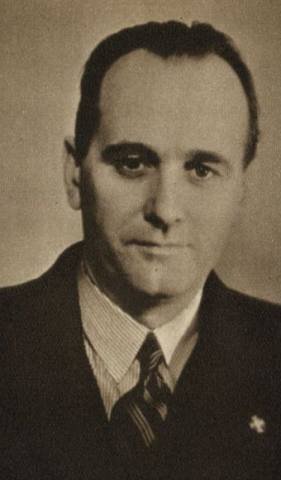After completing his training at the teaching college in Krems an der Donau and his study of art history with Josef Strzygowski at the University of Vienna, Karl Hareiter worked as an art teacher until 1939 and also as a lecturer at the Pädagogische Akademie in Vienna. In the early 1930s he presented the programme Wir besuchen einen Künstler on RAVAG (Radio Verkehrs AG), featuring Secession and Hagenbund artists who had applied until 1937/38 through the magazine Radio Wien to appear on the programme. He visited the studios of artists such as Carry Hauser, Josef Dobrowsky and Franz Zülow. After the annexation of Austria to the German Reich, he wrote articles for the Völkischer Beobachter, for example on the sculptor Wilhelm Frass. The article quotes a letter from Frass, an illegal member of the NSDAP since 1933, to Hareiter referring to a panegyric to the Nazis that he had deposited in the crypt on Heldenplatz in Vienna when his stone figure of a dead warrior was erected in 1935. In 1939 Hareiter was artistic consultant and assistant in Galerie Würthle, which had been Aryanized by Friedrich Welz. As an art historian and private art dealer and collection, Hareiter was particularly interested in the artists Michael Neder and Josef Dobrowsky. After Hareiter's apartment in the 12th district had been damaged in an air raid in 1945, he moved to his grandmother's house in Wieselburg, where he lived until 1948. In the post-war years he was an art consultant on the art market, with contacts to numerous artists and with the intellectuals in Café Museum, Friedrichstraße 6, in the 1st district, and Café Resch at Schönbrunner Straße 246 in the 12th district (now Café Restaurant Schönbrunn). From 1946 he was also in contact with Galerie Agathon, which he joined as partner and director after Ludwig Neumark left in 1948. In this capacity, he sold a work by Max Pechstein in 1949 to the Österreichische Galerie. At the time he was also an adviser to the Viennese art dealer and Neder collector August Maisgeyer. In the systematic research conducted at the Österreichische Galerie it has not been possible to date to determine whether the Pechstein painting was expropriated by the Nazis.
Karl Hareiter

Hans Ankwicz-Kleehoven, Von der Gotik bis Klimt, in: Wiener Zeitung, 23.12.1948, 2, URL: anno.onb.ac.at/cgi-content/anno?aid=wrz&datum=19481223&seite=2 (3.12.2020).
N. N., Salzburg ehrt Hans Makart, in: Salzburger Volksblatt, 29.5.1940, 5–6, URL: anno.onb.ac.at/cgi-content/anno?aid=svb&datum=19400529&seite=5 (3.12.2020).
Leopold Rochowanski, Kunst und Künstler. Ausstellung Max Florian, in: Wiener Kurier, 14.11.1945, 4, URL: anno.onb.ac.at/cgi-content/anno?aid=wku&datum=19451114&seite=4 (3.12.2020).
Herbert Zemen (Hg.), Josef Dobrowsky, 1889–1964, Briefe an Ferdinand Kitt und Rudolf Schussek, Wien 2010.
Karl Hareiter, Der Bildhauer Wilhelm Fraß, in: Völkischer Beobachter, Wiener Ausgabe, 25.12.1938, 6, URL: anno.onb.ac.at/cgi-content/anno?aid=vob&datum=19381225&seite=6 (3.12.2020).
Karl Hareiter, Franz von Zülow, in: Der getreue Eckart 4, 15 (1938), 233–236.
Karl Hareiter, Ein sudetendeutscher Maler. Josef Dobrowsky und sein Werk, in: Völkischer Beobachter, Wiener Ausgabe, 22.11.1938, 9, URL: anno.onb.ac.at/cgi-content/anno?aid=vob&datum=19381122&seite=9 (3.12.2020).
Karl Hareiter, Michael Neder: 1807–1882, Galerie Welz/Salzburg Sommer 1940, Salzburg 1940.
Karl Hareiter, Michael Neder, Wien 1948.
Archiv der Österreichischen Galerie Belvedere, Wien, Zl. 469/1948; 368/1949.
Bürgerservice und Standesamt der Stadtgemeinde Wieselburg.
WStLA, Historische Wiener Meldeunterlagen, Meldeauskunft Karl Hareiter.
